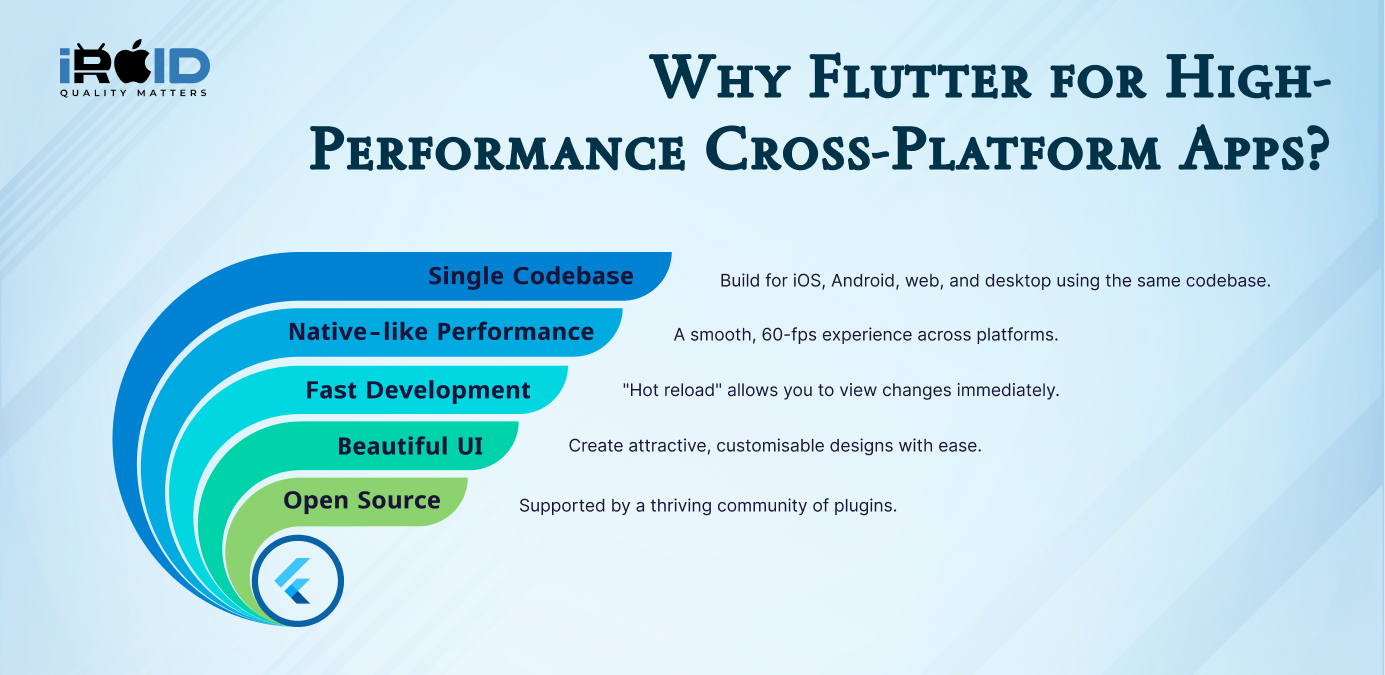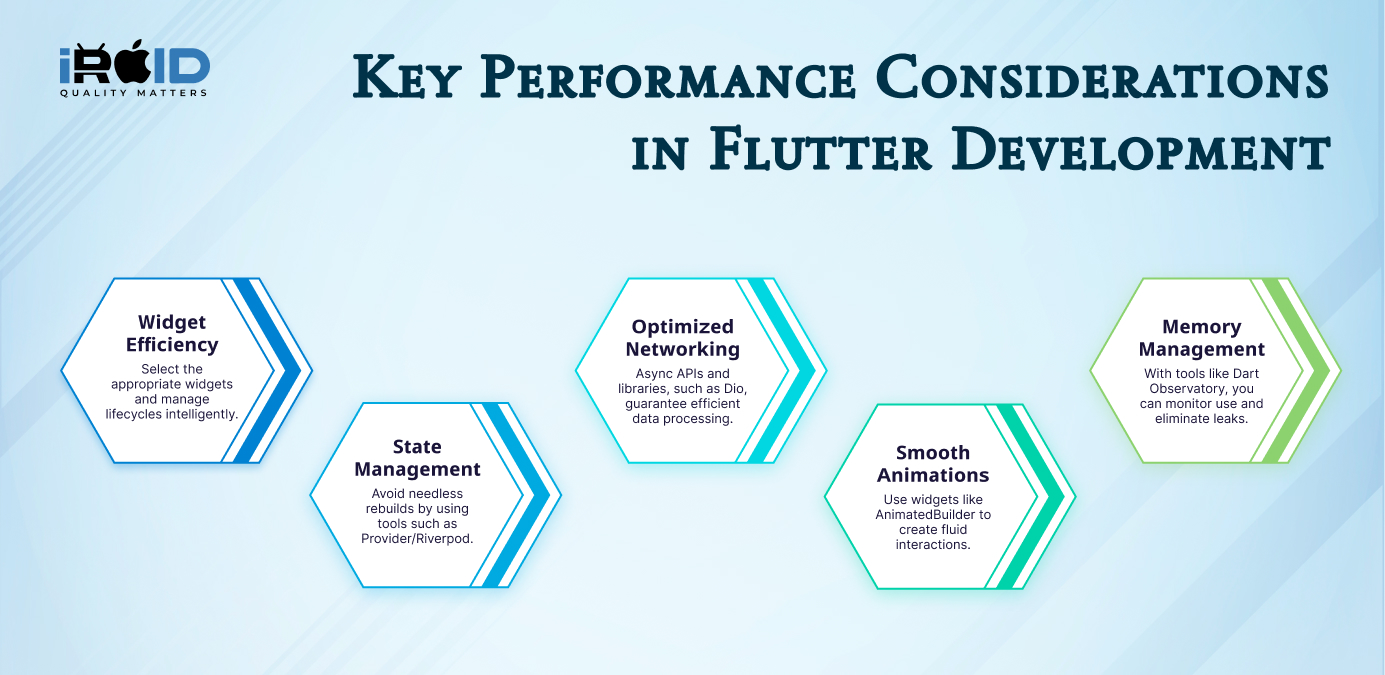Introduction
Hi there! I'm iRoid, and I've been working with Flutter for several years now. As an avid developer and expert blog post writer, I'm excited to share my knowledge and experience in building high-performance cross-platform apps with Flutter. In this blog post, we will explore the benefits of using Flutter, key performance considerations during development, tools, and techniques to improve performance, showcase real-world examples and conclude with some key takeaways. So, let's dive in!
Why Flutter for High-Performance Cross-Platform Apps?

Flutter, a UI toolkit from Google, allows developers to build beautiful, natively compiled applications for mobile, web, desktop, and embedded devices from a single codebase. It offers several advantages that make it an excellent choice for high-performance cross-platform app development.
Single Codebase
With Flutter, you can write code once and deploy it on multiple platforms, including iOS, Android, web, and desktop, saving significant time and development costs. This eliminates the need for separate codebases and simplifies the maintenance process.
Native-like Performance
Flutter leverages the native rendering capabilities of each platform, resulting in smooth and responsive performance. By using its own rendering engine, Flutter achieves consistent 60fps performance on Android and iOS devices, providing a seamless experience to users.
Fast Development
One of the most significant benefits of Flutter is its "hot reload" feature. This allows developers to see the changes in their code reflected instantly on the device, eliminating the need for time-consuming rebuilds and accelerating development cycles. It enables developers to iterate quickly and experiment with different UI designs and features.
Beautiful UI
Flutter offers a rich set of customizable widgets and a powerful rendering engine, enabling developers to create stunning and custom UIs. From simple buttons to complex layouts, Flutter provides the flexibility to build visually appealing and pixel-perfect interfaces that deliver exceptional user experiences.
Open Source and Growing Community
Being an open-source framework, Flutter enjoys a vast and active community. This community provides excellent support, libraries, and plugins for various functionalities, making implementing complex features and solving development challenges easier.
Key Performance Considerations in Flutter Development

To build high-performance Flutter apps, several key performance considerations need to be considered during development. These considerations ensure efficient resource utilization and provide a smooth user experience.
Widget Efficiency
Choosing the right widgets and optimizing their properties is crucial for efficient rendering. Flutter offers a wide range of widgets, each with its own purpose. It's essential to understand the widget tree structure and select the appropriate widgets that best suit the app's requirements. Fine-tuning properties such as stateful vs. stateless widgets and widget lifecycle management can significantly impact performance.
State Management
Efficient state management is vital for Flutter apps to avoid performance bottlenecks. Choosing the right state management solution, such as Provider or Riverpod, helps manage the app's state effectively. By minimizing unnecessary widget rebuilds and efficiently updating only the required parts of the UI, performance can be greatly improved.
Networking and Data Fetching
Fetching data from APIs or performing network operations efficiently is a key consideration for high-performance apps. By using asynchronous tasks and optimized libraries for data retrieval, the main thread can be saved from blocking, ensuring a smooth user experience. Libraries like Dio and HTTP provide excellent support for efficient networking in Flutter.
Animations and Scrolling
Implementing performant animation techniques and optimizing scrolling behaviour are crucial for smooth interaction in Flutter apps. Flutter provides powerful animation APIs and widgets like AnimatedBuilder and ListView, along with optimizations like efficient UI repaints and offscreen widget caching. By leveraging these features, animations and scrolling in Flutter apps can be made buttery smooth.
Memory Management
Monitoring memory usage and implementing proper memory management practices are vital for maintaining app stability and preventing crashes or slowdowns. Flutter provides tools like Dart Observatory and memory profilers to monitor memory consumption and detect memory leaks. Proper resource disposal, using weak references, and managing cache sizes are some memory management practices that greatly impact app performance.
Tools and Techniques for Building High-Performance Flutter Apps
To optimize app performance, Flutter provides several tools and techniques that can be utilized during development.
Flutter DevTools
Flutter DevTools is an essential tool for analysing app performance, identifying bottlenecks, and optimizing code. It offers features like performance profiling, backend analysis, and timeline inspection to gain insights on rendering, network requests, and UI thread-blocking issues. By leveraging DevTools, developers can optimise their code and enhance app performance significantly.
Performance Profiling Tools
Platform-specific profiling tools like Xcode Instruments for iOS and Android Profiler for Android provide valuable information about resource usage, CPU spikes, and memory allocation. These tools help pinpoint performance issues specific to the target platform and guide developers in optimizing their code accordingly.
Code Optimization Techniques
Applying code optimization techniques further enhances performance. Concepts like constant folding and inlining reduce unnecessary function calls and redundant computations, resulting in faster execution. By following best practices like code modularization, reducing unnecessary computations, and utilizing built-in language features, developers can significantly improve app performance.
Leveraging Platform-Specific APIs
Flutter allows developers to access platform-specific APIs when necessary for optimal performance on specific platforms. By utilizing these APIs, apps can take full advantage of the platform's native capabilities and deliver a more immersive user experience.
Case Studies and Examples of High-Performance Flutter Apps
To showcase the real-world potential of Flutter, let's look at a few examples of high-performance apps built with Flutter.
Alibaba
Alibaba, a leading e-commerce company, adopted Flutter to develop their app. With millions of users, Alibaba's decision to use Flutter showcases its scalability and performance. Flutter's smooth animations, rapid development cycle, and native-like experience contributed to the success of Alibaba's app.
WeChat, a widely used messaging app, also implemented Flutter for an improved user experience. Flutter's UI flexibility and performance optimizations enabled WeChat to deliver a feature-rich app with seamless messaging, smooth animations, and fast response times.
ByteDance
ByteDance, the parent company of TikTok, embraced Flutter to create high-performance mobile apps. Flutter's ability to maintain consistent performance across different platforms allows ByteDance to reach a wide user base while providing a smooth and engaging experience.
These case studies highlight how Flutter empowers developers to build high-performance apps while enjoying the benefits of a single codebase and a rich widget library.
Conclusion
In conclusion, Flutter stands out as a powerful tool for building high-performance cross-platform apps with its single codebase, native-like performance, and customizable widgets. By leveraging efficient state management, optimized networking, smooth animations, and robust tools like Flutter DevTools, developers can ensure seamless and engaging user experiences. Real-world examples like Alibaba, WeChat, and ByteDance demonstrate Flutter's scalability and effectiveness in delivering top-notch applications. At iRoid Solutions, we specialize in harnessing the power of Flutter to create innovative, high-performance apps tailored to your business needs. Ready to transform your app idea into reality? Contact us at iRoid Solutions today!
Blog Related FAQs:
Flutter is Google’s open-source UI toolkit for creating natively compiled apps for mobile, web, and desktop from a single codebase. It offers fast development, native-like performance, and beautiful UIs, making it perfect for cross-platform app development.
Flutter uses its own rendering engine and compiles directly to native code, ensuring smooth animations and 60fps performance. Its hot reload feature and optimized widget system also contribute to high efficiency.
Flutter is versatile and can be used to build various apps, including e-commerce platforms, social media apps, on-demand services, LMS systems, and more.
With its single codebase, developers write once and deploy on multiple platforms, reducing development and maintenance time and costs.
Notable apps like Alibaba, WeChat, and ByteDance (parent company of TikTok) use Flutter for their scalability, speed, and seamless user experience.
We use tools like Flutter DevTools, platform-specific profilers (e.g., Xcode Instruments, Android Profiler), and techniques like widget optimization, efficient state management, and memory profiling.
At iRoid Solutions, we focus on creating innovative, high-performance apps tailored to your business needs. We leverage Flutter’s capabilities to deliver scalable and visually appealing solutions.
Contact us at iRoid Solutions today to discuss your project requirements. Let’s bring your app idea to life with Flutter!
Recent Blog Posts
Get in Touch With Us
If you are looking for a solid partner for your projects, send us an email. We'd love to talk to you!














